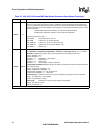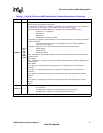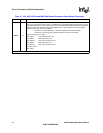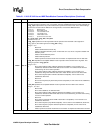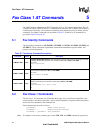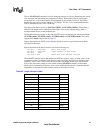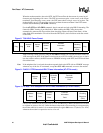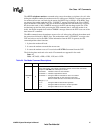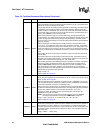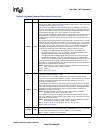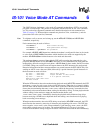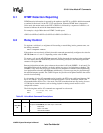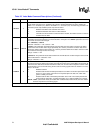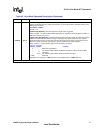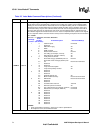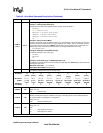
68 536EX Chipset Developer’s Manual
Intel Confidential
Fax Class 1 AT Commands
+FRH=m none
Receive HDLC Data:The +FRH=<mod> command causes the modem to receive
HDLC-framed data using the modulation mode selected in <mod>. The modem then
delivers the next-received frame to the DTE.
If the modem detects the selected carrier signal with an HDLC flag, the modem sends
a ‘CONNECT’ result code to the DTE. If the modem detects a different signal, the
modem sends the ‘+FCERROR’ (fax connect error) result code to the DTE and returns
to command mode. Upon loss of carrier, the modem returns to command mode and
sends a ‘NO CARRIER’ result code to the DTE.
After receiving the HDLC flags, the modem strips away the flags and buffers the
received frames. The modem then transfers the received data to the DTE, starting with
the first non-flag byte and continuing through the last FCS byte. The DTE should
ignore the value of the FCS bytes. The modem also performs HDLC zero-bit deletion
and error checking.
After the FCS bytes are transferred, the modem marks the end of the frame with
<DLE><ETX> and reports the status of the frame reception to the DTE. If the frame
was received correctly (FCS is correct), the modem returns a ‘OK’ result code. If the
frame was received in error (FCS is not correct, carrier lost, or data lost due to data
overflow), the DCE returns an ‘ERROR’ result code. The DTE should then discard this
frame.
After sending the status result code, the modem is ready to accept new commands
from the DTE.
The modem obeys the configured flow control from the DTE. If the DTE sends any
character to the modem other than DC1 or DC3 while the modem is in this mode, the
modem enters command mode and return an ‘OK’ result code.
After sending the result code indicating that frame reception is complete, the modem
continues to receive and buffer the data in the selected mode. If the DTE issues
another +FRH=<mod> command, the modem returns another ‘CONNECT’ result
code and continues with HDLC reception. If the DTE issues any command that
changes modulation, the DCE stops the receive process; the DCE then discards any
buffered data and processes the command.
Range: <mod> = 3
Refer to Table 23 on page 65.
+FRM=m none
Receive Data:The +FRM=<mod> command causes the modem to enter receive
mode using the modulation scheme specified in <mod>. <mod> may have the values
shown in Table 23 on page 65.
When the selected carrier is detected, the modem sends a ‘CONNECT’ result to the
DTE. If a different signal is detected, the modem sends a ‘+FCERROR’ (connect error)
result code to the DTE and returns to command mode.
After receiving the selected carrier, the modem transfers all received data patterns to
the DTE as consecutive start-stop framed bytes, including leading marking conditions
or flags. The modem marks the end of the data stream with <DLE><ETX>.
Upon loss of carrier, the modem returns to command state and sends a ‘NO
CARRIER’ result code to the DTE.
NOTE: If the modem is on-hook, then the modem always returns an ‘ERROR’
message to the DTE after receiving the +FRM=<mod> command.
Range: <mod> = 24, 48, 72, 73, 74, 96, 97, 98, 121, 122, 145, 146
Refer to Table 23 on page 65.
+FRS=m none
Wait for Silence:The +FRS=<TIME> command causes the modem to send an ‘OK’
result code to the DTE when silence has been detected on the line for the amount of
time specified. The value <TIME> is in 10 ms intervals. The command terminates
when the required amount of silence has been detected on the line or the DTE sends
the modem another character that is discarded. In either event, the DTE returns the
‘OK’ result code.
Range: <TIME> = 1–255 (10 ms)
Table 24. Fax Mode Command Descriptions (Continued)
Command Default Description
NOTE: An asterisk (*) denotes the factory-default setting.



